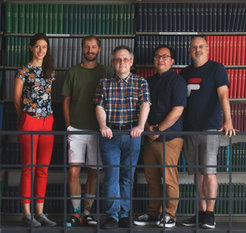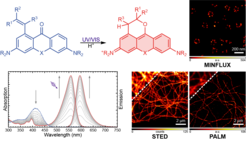A new class of light-controllable fluorescent dyes designed for super-resolution microscopy
Small biocompatible photoactivatable fluorophores, called PaX dyes, enable nanoscale fluorescence imaging with several super-resolution microscopy techniques
Super-resolution microscopy (nanoscopy) is revolutionizing how scientists make the nanoscale organization of living systems visible. These methods make demands on the fluorescent markers used for labeling the samples. A multidisciplinary team of scientists in the Department of Optical Nanoscopy at the Max Planck Institute for Medical Research in Heidelberg has developed a new type of photoactivatable fluorescent marker that meets the unique demands of three different fluorescent nanoscopy methods: STED, PALM and MINFLUX. Their work has now been published in Nature Chemistry.
Fluorescence microscopy has become an indispensable method for understanding the structure of biological systems. With the latest developments in nanoscopic methods such as MINFLUX and MINSTED, optical resolution comparable to the dimensions of small molecules can be achieved. However, this requires that only one fluorescent molecule be present in the area of detection: the remaining markers must be kept in a dark state. Each molecule is observed in turn, to obtain the super-resolution image of a densely labeled structure. Photoactivatable (or "caged") dyes, which are converted into fluorescent molecules upon irradiation with light, are ideal for achieving this.

Several classes of photoactivatable dyes have been proposed for fluorescence nanoscopy applications, each having its own drawbacks. For example, photoactivatable fluorescent proteins suffer from relatively large size, moderate brightness and low photostability, when compared to organic dyes. On the other hand, established caging strategies are known to have varying activation efficiency depending on the chemical structure of the dye or the environment,and in some cases, may generate potentially toxic by-products which could impair nearby proteins or nucleic acids.
Postdoctoral researchers in the Department of Optical Nanoscopy had in mind a completely different photoactivation mechanism when they designed the new family of caging-group-free photoactivatable dyes they called PhotoActivatable Xanthones (PaX dyes). "We put a modern twist on some very classical radical photochemistry”, says Richard Lincoln, co-first author of the paper. “We designed molecules that combine a radical trap in close proximity to a light-activated radical source. When excited with light, the molecule undergoes an intramolecular reaction, quickly assembling into a fluorophore.” Photoactivation of PaX dyes therefore proceeds cleanly and reliably, unaffected by common microscopy buffer constituents or biothiols such as GSH, and without the formation of any potentially harmful by-products. Moreover, as the activation of PaX dyes involves a protonation step, they perform best in aqueous environments at physiological pH, making them suitable for most cellular compartments.

PaX dyes can easily cross cell membranes and the resulting fluorophores show photostability on par with state-of-the-art live cell fluorescent labels. "Their high photostability makes PaX dyes a universal tool in fluorescence microscopy and nanoscopy, suitable for live-cell PALM and STED imaging, color multiplexing, and single-molecule applications, including cutting-edge MINFLUX nanoscopy", says Mariano Bossi, another co-first author of the paper. The PaX dyes were tested and found to be perfectly compatible with several labeling technologies commonly used with living cells, in particular with the popular self-labeling protein tags (HaloTag, SNAP-tag).
"Our work highlights the value of synthetic chemistry in the development of fluorescent probes", says Alexey Butkevich, co-corresponding author of the paper. "The key chemical transformation allowing us to gain access to the diverse range of PaX core structures is a challenging C‒H functionalization". In ongoing work, the chemists from the Department of Optical Nanoscopy are designing further analogues of PaX dyes to expand their color palette and are seeking to diversify their applications in cellular and biomedical imaging.

